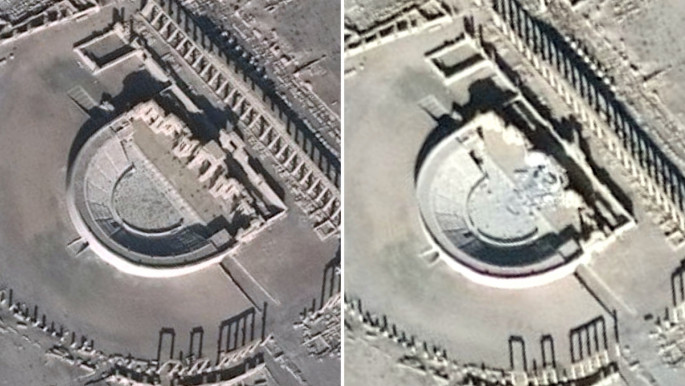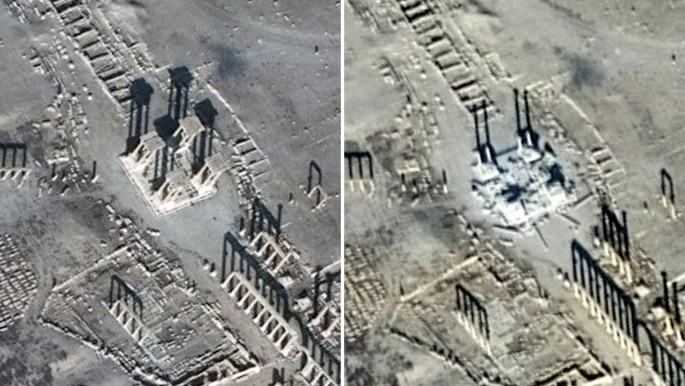Satellite images show what's left of Syria's ancient Palmyra
Satellite images show what's left of Syria's ancient Palmyra
Before and after satellite images show the damage caused to the centuries-old ruins at Syria's Palmyra at the hands of Islamic State vandals.
2 min read
Palmyra's ruins have been destroyed by IS militants [DigitalGlobe]
Satellite images have confirmed the destruction of ancient ruins in the historic Syrian city of Palmyra at the hands of Islamic State militants.
Parts of the Roman amphitheatre and columns of the Tetrapylon have been desecrated after the city was recaptured from regime forces last month.
Militants also carried out mass executions in the ruins of the amphitheatre, said the UN's culture agency UNESCO, as it condemned the destruction at the World Heritage site.
UNESCO has urged the international community to "stand against cultural cleansing".
Calling the destruction "a new war crime and an immense loss for the Syrian people and for humanity," Director-General Irina Bokova added the destruction sought "to destroy both human lives and historical monuments in order to deprive the Syrian people of its past and its future".
Before and after images from the UN's Institute for Training and Research show the stage backdrop of the Roman amphitheatre has sustained severe damage, with rubble seen visibly spilling onto the stage.
Two columns of the Tetrapylon remain standing but the rest of the structure has been nearly completely destroyed, with debris visible on the ground.
The UN Security Council also expressed concern on Friday that IS and other groups associated with al-Qaeda are looting, smuggling and selling Syria's archaeological treasures "to support their recruitment efforts and to strengthen their operational capability to organise and carry out terrorist attacks".
An oasis in the Syrian desert, northeast of Damascus, Palmyra contains monumental ruins of a city that was one of the most important cultural centres of the ancient world.
From the 1st to the 2nd century, the art and architecture of Palmyra, standing at the crossroads of several civilisations, married Greco-Roman techniques with local traditions and Persian influences.
Parts of the Roman amphitheatre and columns of the Tetrapylon have been desecrated after the city was recaptured from regime forces last month.
Militants also carried out mass executions in the ruins of the amphitheatre, said the UN's culture agency UNESCO, as it condemned the destruction at the World Heritage site.
UNESCO has urged the international community to "stand against cultural cleansing".
Calling the destruction "a new war crime and an immense loss for the Syrian people and for humanity," Director-General Irina Bokova added the destruction sought "to destroy both human lives and historical monuments in order to deprive the Syrian people of its past and its future".
Before and after images from the UN's Institute for Training and Research show the stage backdrop of the Roman amphitheatre has sustained severe damage, with rubble seen visibly spilling onto the stage.
 |
| Before and after: The Roman amphitheatre [DigitalGlobe] |
Two columns of the Tetrapylon remain standing but the rest of the structure has been nearly completely destroyed, with debris visible on the ground.
 |
| Before and after: The Tetrapylon in Palmyra [DigitalGlobe] |
The UN Security Council also expressed concern on Friday that IS and other groups associated with al-Qaeda are looting, smuggling and selling Syria's archaeological treasures "to support their recruitment efforts and to strengthen their operational capability to organise and carry out terrorist attacks".
An oasis in the Syrian desert, northeast of Damascus, Palmyra contains monumental ruins of a city that was one of the most important cultural centres of the ancient world.
From the 1st to the 2nd century, the art and architecture of Palmyra, standing at the crossroads of several civilisations, married Greco-Roman techniques with local traditions and Persian influences.
![Palmyra destruction [DigitalGlobe] Palmyra destruction [DigitalGlobe]](/sites/default/files/styles/large_16_9/public/media/images/EE14F29D-E0C1-4127-A370-0A47DC1C992D.jpg?h=d1cb525d&itok=_8w8dwIA)


